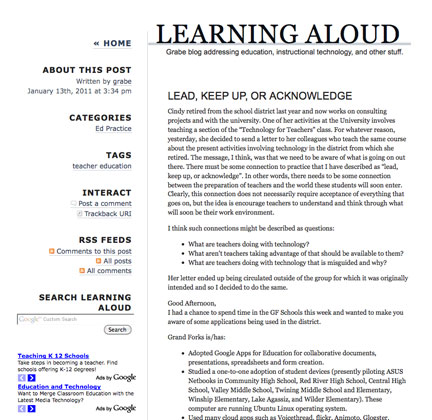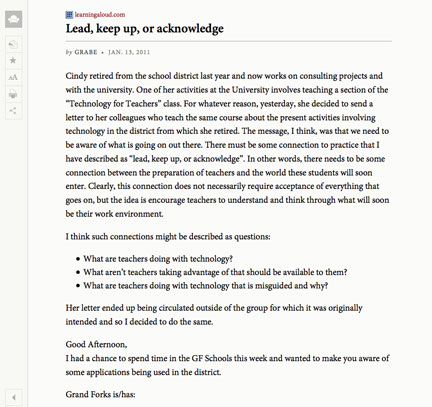I will get around to explaining the title near the end of this post.
In my previous post, I introduced an interesting idea I read about in MacWorld. The MacWorld article described a new service, Readability, and interesting mechanism for supporting content creators proposed by the company that created Readability.
So many of us make heavy use of products that organize and archive online content created by others. We use tools such as Diigo, Evernote, my current favorite Instapaper, or similar products to organize and archive resources. In a way, Readability does the same and is very much like Instapaper. It identifies the core content on a web page and archives this content without the “clutter” surrounding the content of interest. If you compare the following two images (reduced in size), it is pretty easy to see what I mean by reducing clutter. The core content is certainly presented in a way that is more readable.


What the developers of Readability noted was that what I have described as clutter may contain things, such as ads and links, the authors of content want you to see. Much in the same way we may skip over the ads in television content by using a TiVo or similar recording device, we have access to tools that allow us to ignore services that content developers may be counting on to support their commitment of time. The Reading people have proposed an alternative funding model. You put in $5 a month (or more). The money is collected by Amazon. The company creating Readability keeps 30% and distributes 70% to participating content providers. So, if you few the full pages you see the ads. If you avoid the ads by using Readability and sign up for “the plan”, you contribute with clicking through ad links.
So, I am giving it a try. I have committed my $60 AND I have signed up as a content provider. It is kind of an experiment. I wonder if this idea will go anywhere. It assumes people will be willing to make a contribution to support online content. You get to see how your $3.50 is allocated each month. I think it will be interesting to see who participates.
I am thinking it must be very early. The Readability web site describes apps for mobile devices and as far as I can tell, these apps are not yet available. There is also a predicted collaboration with Instapaper that I think has yet to actually be put into play.
Back to my title. I am coming to the conclusion that “the short form” is not enough. By this I am making a distinction between blog posts and books, between conference keynotes and courses, etc. I am certainly not implying that posts and presentations are not interesting or useful, I am suggesting that they are not sufficient as educational resources. We have access to the stuff that is relatively easy to create, but not to resources that offer the big picture and tie things together. It takes far more work to offer long form content and this is what I am predicting we lose when we ignore and even circumvent ways to encourage author/developers to focus their time on larger products.
Powered by ScribeFire.
![]()